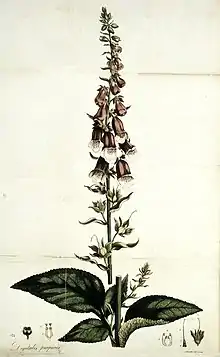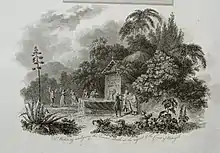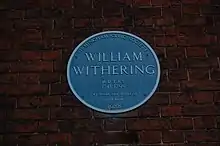William Withering FRS | |
|---|---|
 | |
| Born | 17 March 1741 Wellington, Shropshire, England |
| Died | 6 October 1799 (aged 58) Sparkbrook, Birmingham, England |
| Nationality | English |
| Citizenship | Great Britain |
| Known for | Discovery of digitalis |
| Scientific career | |
| Fields | Botanist, geologist, chemist, physician |
| Academic advisors | William Cullen |
| Signature | |
 | |
William Withering FRS (17 March 1741 – 6 October 1799) was an English botanist, geologist, chemist, physician and first systematic investigator of the bioactivity of digitalis.
Withering was born in Wellington, Shropshire, the son of a surgeon.[1] He trained as a physician and studied medicine at the University of Edinburgh Medical School. He worked at Birmingham General Hospital from 1779. The story is that he noticed a person with dropsy (swelling from congestive heart failure) improve remarkably after taking a traditional herbal remedy; Withering became famous for recognising that the active ingredient in the mixture came from the foxglove plant.[2] The active ingredient is now known as digoxin, after the plant's scientific name. In 1785, Withering published An Account of the Foxglove and some of its Medical Uses, which contained reports on clinical trials and notes on digitalis's effects and toxicity.[3]
Biography
Born in England, Withering attended Edinburgh Medical School from 1762 to 1766. In 1767 he started as a consultant at Stafford Royal Infirmary. He married Helena Cookes (an amateur botanical illustrator, and a former patient of his) in 1772; they had three children (the first, Helena was born in 1775 but died a few days later, William was born in 1776, and Charlotte in 1778). In 1775 he was appointed physician to Birmingham General Hospital (at the suggestion of Erasmus Darwin, a physician and founder member of the Lunar Society), but in 1783 he diagnosed himself as having pulmonary tuberculosis and went twice to Portugal hoping the better winter climate would improve his health; it did not. On the way home from his second trip there, the ship he was in was chased by pirates. In 1785 he was elected a Fellow of the prestigious Royal Society and also published his Account of the Foxglove (see below). The following year he leased Edgbaston Hall, in Birmingham. He was one of the members of the Lunar Society.[4] During the Birmingham riots of 1791 (in which Joseph Priestley's home was demolished) he prepared to flee from Edgbaston Hall, but his staff kept the rioters at bay until the military arrived. In 1799 he decided that he could not tolerate another winter in the cold and draughty Hall, so he bought "The Larches" in the nearby Sparkbrook area; his wife did not feel up to the move and remained at Edgbaston Hall. After moving to The Larches on 28 September, he died on 6 October 1799.
Botany


In 1776, he published The botanical arrangement of all the vegetables naturally growing in Great Britain,[5][6] an early and influential British Flora. It was the first in English based on the then new Linnaean taxonomy — a classification of all living things — devised by the Swedish botanist and physician Carl Linnaeus (1707–1778). At the time he was criticised for having produced a bowdlerised version of Linnaeus, deliberately omitting any references to sexual reproduction, out of a desire to protect 'female modesty', notably by 'A Botanical Society, at Lichfield' - almost always incorrectly named as The Botanical Society of Lichfield or the Lichfield Botanical Society. Withering explained on the title page and his introduction that he avoided being explicit to allow his book to be used without any problems by a wider audience and in particular women.[7][notes 1] However he found support for his position, and botany was considered a subject suitable for many women during the next century.[8][9] A talented illustrator herself, his wife, Helena, sketched plants he collected.[10]
Withering wrote two more editions of this work in 1787 and 1792, in collaboration with fellow Lunar Society member Jonathan Stokes, and after his death his son (also William) published four more. It continued being published under various authors until 1877. Withering senior also carried out pioneering work into the identification of fungi and invented a folding pocket microscope for use on botanical field trips. He also introduced to the general audience the screw down plant press and the vasculum.[11] In 1787 he was elected a Fellow of the Linnaean Society in recognition of his contribution to botany. Subsequently, the plant Witheringia solanacea was named in his honour, and he became known on the continent of Europe as "The English Linnaeus". The William Withering Chair in Medicine at the University of Birmingham Medical School is named after him, as is the medical school's annual William Withering Lecture.
Discovery of digitalis
Allegedly, Withering first learned of the use of digitalis in treating "dropsy" (œdema) from "Mother Hutton", an old woman who practised as a folk herbalist in Shropshire, who used the plant as part of a polyherbal formulation containing over 20 different ingredients to successfully treat this condition.[13][14][15] Withering deduced that digitalis was the active ingredient in the formulation, and over the ensuing nine years he carefully tried out different preparations of various parts of the plant (collected in different seasons) documenting 156 cases where he had employed digitalis, and describing the effects and the best - and safest - way of using it. At least one of these cases was a patient for whom Erasmus Darwin had asked Withering for his second opinion. In January 1785 Darwin submitted a paper entitled "An Account of the Successful Use of Foxglove in Some Dropsies and in Pulmonary Consumption" to the College of Physicians in London;[16] it was presented by Darwin in March of that year. A postscript[17] at the end of the published volume of transactions containing Darwin's paper states that "Whilst the last pages of this volume were in the press, Dr Withering of Birmingham... published a numerous collection of cases in which foxglove has been given, and frequently with good success". After this, Darwin and Withering became increasingly estranged, and eventually an argument broke out apparently resulting from Robert Darwin having accused Withering of unprofessional behaviour by effectively poaching patients. This is a very early example of medical academic plagiarism. This was in reality orchestrated by Erasmus Darwin, a man whose anger and sarcasm when he felt slighted had in all likelihood contributed to the suicide of his own son and later to the estrangement of his son Robert.

In reality "Mother Hutton" was created in 1928 in an illustration by William Meade Prince as part of an advertising campaign by Parke-Davis who marketed digitalis preparations. There is no mention of a Mother Hutton in Withering's works or anyone else's and no mention of him meeting any old woman directly. In his account he states that he is merely asked to comment on a family recipe that was originally an old woman's receipt or recipe (that she had long kept secret) by a colleague. Since 1928, Mother Hutton's status has grown from being an image in an advertising poster to an acclaimed wise woman, herbalist, pharmacist and medical practitioner in Shropshire who was cheated out of her true recognition by Dr. Withering's unscrupulous methods. The story often written around this is also totally apocryphal. Withering was in fact informed of the Brasenose College, Oxford case by one of his medical colleagues Dr. Ash at Birmingham Hospital and the Dean was treated with digitalis root not leaves. The myth of Mother Hutton and how Withering chased her around Shropshire has been created by authors not going back to primary sources but instead copying and then embellishing the unreferenced work of others. See "Withering and The Foxglove; the making of a myth" by D.M. Krikler (British Heart Journal, 1985, 54: 256–257). In Withering's Account of the Foxglove printed in 1785 Withering mentions seven different occasions when foxglove was brought to his attention. Recognising that foxglove was the active ingredient in a family recipe (that was long kept secret by an old woman in Shropshire) would not have been difficult with his expert botanical knowledge. Withering had first published his Botanical Arrangement in 1776 and in it suggested foxglove deserved looking at in more detail. Erasmus Darwin tried to take the credit for foxglove and failed. Erasmus Darwin then attempted to try and discredit Withering behind the scenes with the unwitting help of his son Robert having earlier used the thesis of his dead son Charles to try and establish priority. Charles Darwin in fact had been friendly with Withering (as had Robert) and had talked in Edinburgh University about Withering's experiments with foxglove. Erasmus Darwin was probably jealous that Withering had become the most famous and sought-after doctor outside London and that Withering's English Botanical Arrangement became the standard reference source and far exceeded the botanical publications of Erasmus (all published semi-anonymously) in popularity. Withering's Botanical Arrangement, although now almost forgotten, became the standard reference for English Botany for almost the next 100 years.
Chemistry and geology

Withering was an enthusiastic chemist and geologist. He conducted a series of experiments on Terra Ponderosa, a heavy ore from Cumberland, England. He deduced that it contained a hitherto undescribed element which he was unable to characterise. It was later shown to be barium carbonate and in 1789 the German geologist Abraham Gottlob Werner named the mineral Witherite in his honour.[18] The Matthew Boulton mineral collection of Birmingham Museum and Art Gallery may contain one of the earliest known specimens of witherite. A label in Boulton's handwriting records; "No.2 Terra Ponderosa Aerata, given me by Dr. Withering"[19]
Withering also undertook analyses of the mineral content of a number of spa waters in England and abroad, notably at the medicinal spa at Caldas da Rainha in Portugal. This latter undertaking occurred during the winter of 1793–4, and he was subsequently elected to the Fellowship of the Royal Academy of Sciences of Portugal.
Memorials

He was buried on 10 October 1799 in Edgbaston Old Church next to Edgbaston Hall, Birmingham, although the exact site of his grave is unknown. The memorial stone, now moved inside the church, has foxgloves and Witheringia solanaceae carved upon it to commemorate his discovery and his wider contribution to botany. He is also remembered by one of the Lunar Society Moonstones in Birmingham and by a blue plaque at Edgbaston Hall.[20] Birmingham University School of Medicine[21] established a Chair of Medicine post in his honour, named after him.[22]
In July 2011 a J D Wetherspoon public house opened in Withering's birthplace, Wellington, and has been named after him.[23]
Publications

This list is drawn from Sheldon, 2004:[24]
- 1766 Dissertation on angina gangrenosa
- 1773 "Experiments on different kinds of Marle found in Staffordshire" Phil Trans. 63: 161-2
- Withering, William (1776a). A Botanical Arrangement of All the Vegetables Naturally Growing in Great Britain: With Descriptions of the Genera and Species, According to the System of the Celebrated Linnaeus. Being an Attempt to Render Them Familiar to Those who are Unacquainted with the Learned Languages. vol i. Birmingham: Swinney. Retrieved 24 February 2015.
- Withering, William (1776b). A Botanical Arrangement of All the Vegetables Naturally Growing in Great Britain: With Descriptions of the Genera and Species, According to the System of the Celebrated Linnaeus. Being an Attempt to Render Them Familiar to Those who are Unacquainted with the Learned Languages. vol ii. Birmingham: Swinney. Retrieved 24 February 2015.
- 1779 "An account of the scarlet fever and sore throat, or scarlatina; particularly as it appeared at Birmingham in the year 1778" Publ Cadell London
- 1782 "An analysis of two mineral substance, vz. the Rowley rag-stone and the toad stone" Phil Trans 72: 327-36
- 1783 "Outlines of mineralogy" Publ Cadell, London (a translation of Bergmann's Latin original)
- 1784 "Experiments and observations on the terra ponderosa" Phil trans 74: 293-311
- 1785 "An account of the foxglove and some of its medical uses; with practical remarks on the dropsy, and some other diseases" Publ Swinney, Birmingham
- 1787 "A botanical arrangement of British plants..." 2nd ed. Publ Swinney, London
- 1788 Letter to Joseph Priestley on the principle of acidity, the decomposition of water. Phil Trans 78: 319-330
- 1790 "An account of some extraordinary effects of lightning" Phil Trans 80: 293-5
- 1793 "An account of the scarlet fever and sore throat..." 2nd ed Publ Robinson, London
- 1793 "A chemical analysis of waters at Caldas" extract from Actas da Academica real das Sciencias
- 1794 "A new method for preserving fungi, ascertained by chymical experiments" Trans Linnean Soc 2: 263-6
- 1795 "Analyse chimica da aqua das Caldas da Rainha" Lisbon (a chemical analysis of the water of Caldas da Rainha)
- 1796 "Observations on the pneumatic medicine" Ann Med 1: 392-3
- 1796 "An arrangement of British plants..." 3rd ed. Publ Swinney, London
- 1799 "An account of a convenient method of inhaling the vapour of volatile substances" Ann Med 3: 47-51
Notes
- ↑ "Dr. Withering...has translated parts of the Genera and Species Plantarum of LINNEUS; but has entirely omitted the sexual distinctions, which are essential to the philosophy of the system"
References
- ↑ "William Withering (1741-1799), a biographical sketch of a Birmingham Lunatic. - The James Lind Library". The James Lind Library. Retrieved 24 August 2017.
- ↑ Haughton, Claire (1980). Green Immigrants. New York: Harcourt, Brace, Jovanovich. pp. 133–134. ISBN 0-15-636492-1.
- ↑ William Withering, An Account of the Foxglove and some of its Medical Uses (Birmingham, England: M. Swinney, 1785).
- ↑ "William Withering (1741-1799): A Birmingham Lunatic" Proc R Coll Physicians Edinb 2001; 31:77-83. Accessed 28 June 2009
- ↑ Withering 1776a.
- ↑ Withering 1776b.
- ↑ Linné 1785, preface of the Translators p. ii.
- ↑ George 2007.
- ↑ Fara 2003.
- ↑ "William Withering | English physician". Encyclopedia Britannica. Retrieved 24 August 2017.
- ↑ Jane Mygatt (2001). "A Case for Collecting" (PDF). Iowa Native Plant Society Newsletter. 7 (3): 5–6. Retrieved 30 December 2015.
- ↑ International Plant Names Index. With.
- ↑ "Molecular Interventions - CLOCKSS". aspetjournals.org.
- ↑ "Royal Pharmaceutical Society | RPS" (PDF).
- ↑ Krikler, Dennis M. (May 1985). "The foxglove, "The old woman from Shropshire" and William Withering". J. Am. Coll. Cardiol. 5 (5 Suppl A): 3A–9A. doi:10.1016/s0735-1097(85)80457-5. PMID 3886750.
- ↑ Medical Transactions, Volume 3, 1785, published by the College of Physicians, London. Transaction XVI, pp 255-286
- ↑ Medical Transactions, Volume 3, 1785, published by the College of Physicians, London. Transaction XXVIII, p 448
- ↑ "William Withering (1741-1799): a biographical sketch of a Birmingham Lunatic." M R Lee, James Lind Library, accessed 25 September 2006
- ↑ Starkey, R. E. (2011). "Matthew Boulton, his mineral collection and the Lunar Men". The Newsletter of the Russell Society. 59: 1–8.
- ↑ Birmingham Civic Society Archived 29 September 2011 at the Wayback Machine
- ↑ "Medicine at the University of Birmingham | Medical School - University of Birmingham". www.birmingham.ac.uk. Retrieved 6 November 2018.
- ↑ "Professor Wiebke Arlt - Institute of Metabolism and Systems Research - University of Birmingham". www.birmingham.ac.uk. Retrieved 6 November 2018.
- ↑ Wellington News July 2011
- ↑ Sheldon, Peter (2004). The Life and Times of William Withering: His Work, His Legacy. ISBN 978-1-85858-240-5
Further reading
- George, Sam (2007). Botany, sexuality, and women's writing 1760-1830 : from modest shoot to forward plant. Manchester: Manchester University Press. ISBN 9780719076978. Retrieved 23 February 2015.
- William Withering Junior (1822). Miscellaneous Tracts. Two volumes: a memoir by Withering's son, and a collection of many of his writings
- Louis H Roddis (1936). William Withering - The Introduction of Digitalis into Clinical Practice. A brief biography
- TW Peck and KD Wilkinson (1950). William Withering of Birmingham. A detailed biography
- Mann, Ronald David (1985). William Withering and the Foxglove: A Bicentennial Selection of Letters from the Osler Bequest to the Royal Society of Medicine. Lancaster: MTP Press. ISBN 9780852009505.
- J K Aronson (1985). An Account of the Foxglove and its Medical Uses 1785-1985. An annotated version of the Withering's work, with a modern analysis of the cases described
- Jenny Uglow (2002). The Lunar Men. ISBN 0-571-19647-0. An account of the members of the Lunar Society, their endeavours, and relationships
- Linné, Carl von (1785) [1774]. Systema vegetabilium (13th edition of Systema Naturae) [A System of Vegetables 2 vols.]. Lichfield: Lichfield Botanical Society. Retrieved 24 February 2015.
- Fara, Patricia (2003). Sex, Botany and Empire: The Story of Carl Linnaeus and Joseph Banks. Cambridge: Icon Books. ISBN 9781840464443. Retrieved 22 February 2015.
